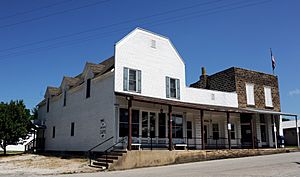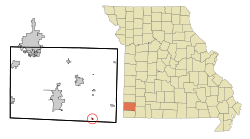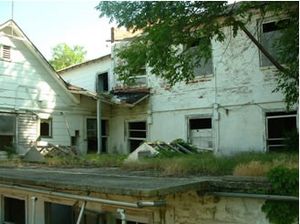Stella, Missouri facts for kids
Quick facts for kids
Stella, Missouri
|
|
|---|---|

Historic Lentz-Carter Merchandise Store
|
|

Location of Stella, Missouri
|
|
| Country | United States |
| State | Missouri |
| County | Newton |
| Area | |
| • Total | 0.16 sq mi (0.42 km2) |
| • Land | 0.16 sq mi (0.42 km2) |
| • Water | 0.00 sq mi (0.00 km2) |
| Elevation | 1,155 ft (352 m) |
| Population
(2020)
|
|
| • Total | 166 |
| • Density | 1,018.40/sq mi (392.12/km2) |
| Time zone | UTC-6 (Central (CST)) |
| • Summer (DST) | UTC-5 (CDT) |
| ZIP code |
64867
|
| Area code(s) | 417 |
| FIPS code | 29-70648 |
| GNIS feature ID | 2397681 |
Stella is a small village in southern Newton County, Missouri, in the United States. In 2010, about 158 people lived there. Stella is part of the larger Joplin Metropolitan Area. It is located about 17 miles southeast of Neosho.
Contents
History of Stella, Missouri
The first people known to settle in this area arrived in the early 1820s. Before it was called Stella, the area was a fishing community known as Springs. In October 1880, the St. Louis and San Francisco Railroad sold some land to Moses Eagle for $200. His family had moved to the area in 1844.
Stella officially became a town in 1930. It was named after Moses Eagle's granddaughter. Moses Eagle also built a mill powered by water in 1867. The Bank of Stella opened around 1900. The first newspaper in the area, the Amicus Curio, started in 1901. Later, the Stella Enterprise and the Stella Weekly Record also began.
The Horner Institute joined with the Stella Academy in 1911. It stayed in Stella until it moved to Purdy in 1912. The Stella Baptist Church was started in 1886, and its building was finished around 1911. The Stella Methodist Church began around 1896, and the Stella Church of Christ was established after 1950.
The Lentz-Carter Merchandise Store is an important building in Stella. It was added to the National Register of Historic Places in 2008 because of its historical value.
Cardwell Hospital: A Local Landmark
Clarence C. Cardwell and the Hospital's Beginning
Even though Stella is a small village, it had an important hospital for almost 60 years. This was the Cardwell Hospital, which later became the Cardwell Memorial Osteopathic Hospital. It helped many people from the nearby rural areas of Newton, Barry, and McDonald counties.
Clarence C. Cardwell, a World War I veteran, opened the hospital in 1920. He was born near Stella in 1892. At first, the hospital only had four rooms. But it grew bigger to serve the community. By 1930, a second doctor joined the hospital staff, and it had 10 beds for patients. A fire damaged the hospital in 1942, but Cardwell quickly rebuilt it.
Clarence Cardwell ran the hospital with his wife, Ida Cardwell, and their daughter, Cleta Cardwell. He continued this work until he passed away in November 1956. At that time, the Cardwell Hospital was said to have grown to 100 beds.
After Clarence Cardwell's death, the hospital closed for a short time. Then, Silas and Lillian Fountain bought it from Ida and Cleta Cardwell. They reopened it on February 11, 1957, as the Cardwell Memorial Osteopathic Hospital. The Fountains were a married couple from Sulphur Springs, Arkansas. Both had studied at the Kansas City College of Osteopathy and Surgery. Their daughter, Mary Sue Fountain, managed the hospital. After her husband Silas died in June 1973, Lillian Fountain continued to run the hospital until 1977. Lillian Fountain passed away in October 1996.
Hospital Closure and Environmental Cleanup
The Cardwell Memorial Osteopathic Hospital closed in 1977. However, the building soon reopened as a residential care facility. This was owned by Don and Vera Littlefield. But this business did not last long, and the building was empty by the mid-1980s.
The building sat empty for almost 20 years. The people of Stella wanted to improve their town's business district. They suggested turning the old hospital into a new building. This new building would have a clinic, a library, city hall, shops, and homes.
However, the building had a lot of asbestos contamination. Asbestos is a dangerous material. Because of this, the decision was made to tear down the old building. The Environmental Protection Agency (EPA) called the former Cardwell Hospital building a superfund site. This means it was a very polluted place that needed a special cleanup. The EPA helped the town remove the building safely.
In the summer of 2006, the old Cardwell Hospital was torn down. The site was cleaned to remove all the contamination. This made the area safe for new uses. After the building was removed, the site became the Stella Veterans Memorial Park. This park honors veterans from the Stella area.
Stella's Doctors and Dentists
During the years the Cardwell Hospital was open, especially when Clarence Cardwell owned it, Stella became known for something special. It is believed that more than 30 doctors and dentists came from the town. Most of them are thought to have worked at the Cardwell Hospital when they were young.
Geography of Stella
Stella is located on the northeast side of South Indian Creek. It is about half a mile north of the border between Newton and McDonald counties. You can reach Stella using Missouri Routes O and F. Missouri Route 76 is about 2.5 miles to the south.
According to the United States Census Bureau, the village covers a total area of about 0.16 square miles (0.42 square kilometers). All of this area is land.
Population Information
| Historical population | |||
|---|---|---|---|
| Census | Pop. | %± | |
| 1930 | 226 | — | |
| 1940 | 221 | −2.2% | |
| 1950 | 177 | −19.9% | |
| 1960 | 166 | −6.2% | |
| 1970 | 197 | 18.7% | |
| 1980 | 230 | 16.8% | |
| 1990 | 132 | −42.6% | |
| 2000 | 178 | 34.8% | |
| 2010 | 158 | −11.2% | |
| 2020 | 166 | 5.1% | |
| U.S. Decennial Census | |||
2010 Census Details
In 2010, there were 158 people living in Stella. These people lived in 65 households, and 40 of these were families. The village had about 987.5 people per square mile. There were 83 housing units in total.
Most of the people in Stella were White (89.9%). A smaller number were Native American (5.1%) or Asian (5.1%). About 0.6% of the population was Hispanic or Latino.
- About 36.9% of households had children under 18 living with them.
- 44.6% were married couples living together.
- 13.8% had a female head of household with no husband.
- 3.1% had a male head of household with no wife.
- 38.5% were not families.
About 33.8% of all households were made up of single individuals. 17% of households had someone living alone who was 65 years old or older. The average household had 2.43 people, and the average family had 3.20 people.
The average age in the village was 37.5 years.
- 27.8% of residents were under 18.
- 10.2% were between 18 and 24.
- 22.3% were between 25 and 44.
- 25.3% were between 45 and 64.
- 14.6% were 65 or older.
The population was almost evenly split between males (48.7%) and females (51.3%).
See also
 In Spanish: Stella (Misuri) para niños
In Spanish: Stella (Misuri) para niños


